Vector Laboratories is closed for the President’s Day on Monday, February 19th. We will be back in the office on Tuesday, February 20th.
We will respond to emails upon our return. Have a wonderful day.
Menu
Vector Laboratories is closed for the President’s Day on Monday, February 19th. We will be back in the office on Tuesday, February 20th.
We will respond to emails upon our return. Have a wonderful day.
The DuoLuX Chemiluminescent/Chemifluorescent Alkaline Phosphatase Substrate is a unique formula based on acridan chemistry. It is supplied for alkaline phosphatase development and can be used for western, Southern, northern, or dot blots, or for ELISA applications.
Contents:
| Unit Size | 100 ml |
|---|---|
| Applications | Blotting Applications, Elispot, ELISAs |
| Detection Enzyme(s) | Alkaline Phosphatase |
| Substrate Reaction Product | Chemiluminescent/ Chemifluorescent Product |
This substrate is about 10 times more sensitive than the alkaline phosphatase substrate BCIP/NBT and about 100 times more sensitive than the peroxidase substrate DAB.
The DuoLuX Chemiluminescent/Chemifluorescent Substrate for alkaline phophatase (SK-6605) is supplied in ready-to-use form, consisting of 100 ml of substrate solution.
Light emission of the DuoLuX Chemiluminescent/ Chemifluorescent Substrate occurs continuously over a long period of time for both the peroxidase and alkaline phosphatase substrates. With either substrate formula, reacted DuoLuX Substrate luminesces in the blue range with a peak emission at 453 nm. Unlike other chemiluminescent substrates, blots can be reexposed to film many times over an 8 hour period to optimize band intensities or resolution.
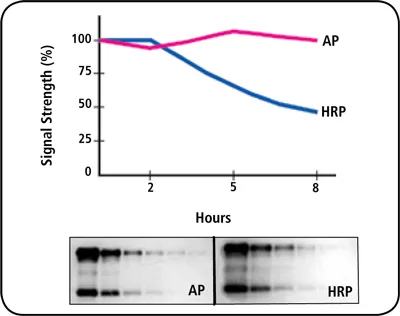
Serial dilutions (1:2) of mouse IgG were resolved by PAGE, transferred onto nitrocellulose membrane and detected with the DuoLuX™ Substrate using either the Alkaline Phosphatase-based VECTASTAIN® ABC-AmP Kit (lower left) or Peroxidase Streptavidin (lower right). Graph shows prolonged light emission characteristics of the DuoLuX™ Substrate with each enzyme.
In addition to its chemiluminescent properties, the reaction product of the DuoLuX Substrate is also fluorescent. Fluorescence can be recorded with a digital imaging system or a conventional camera months after chemiluminescence has faded. The excitation maximum is at 405 nm, but other wavelengths (254 nm and 365 nm) also excite. Maximum fluorescent emission occurs at 453 nm. For fluorescence detection, nitrocellulose is recommended due to the intrinsic fluorescence of nylon. Acquisition of fluorescent signal requires a much shorter exposure time than chemiluminescence, often a fraction of a second.
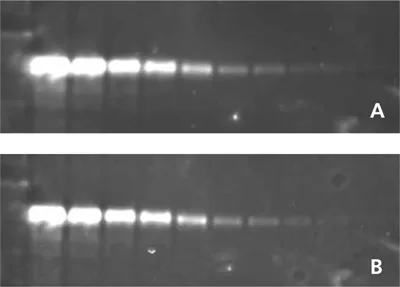
Western blot visualized by fluorescence using the VECTASTAIN® ABC-AmP Kit with the DuoLuX™ Substrate. Serial dilutions (1:2) of rabbit IgG heavy chain were resolved by PAGE, transferred onto nitrocellulose membrane, and detected with biotinylated anti-rabbit IgG, followed by the VECTASTAIN® ABC-AmP Kit with the DuoLuX™Substrate. [A] Fluorescent detection by image acquisition (1 second). [B] Fluorescent image of the same blot as shown in [A] obtained 12 months later. (Same 1 second acquisition time.)
The DuoLuX Chemiluminescent/Chemifluorescent Substrate is ideal for development of protein and nucleic acid blots. Complete kits are available for western blot development (VECTASTAIN® ABC-AmP system).
For western For western blot applications using chemiluminescent detection, the sensitivity using either alkaline phosphatase or peroxidase is approximately 1 pg of protein. Film exposure times using peroxidase are generally 5-30 seconds; exposure times for alkaline phosphatase are 1-5 minutes. Using fluorescence detection, sensitivities are less than 10 pg of protein. For western blots, DuoLuX™ Chemiluminescent/Chemifluorescent Substrate can be used on either nitrocellulose or PVDF membranes but, in general, nitrocellulose is preferred.
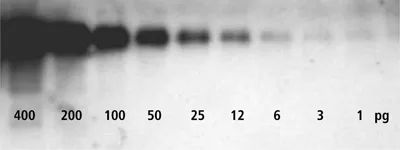
Western blot visualized by chemiluminescence. Serial dilutions of rabbit IgG heavy chain were resolved by electrophoresis, transferred onto nitrocellulose membrane and detected with biotinylated anti-rabbit IgG, using the VECTASTAIN® ABC-AmP Kit with the DuoLuX™ Substrate. Chemiluminescent detection was captured by exposure to film.
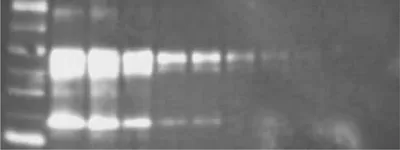
Western blot visualized by fluorescence. Serial dilutions (1:2) of mouse IgG were resolved by PAGE, transferred onto nitrocellulose membrane, and detected with biotinylated anti-mouse IgG, Peroxidase Streptavidin and the DuoLuX™ Substrate. Fluorescent image was obtained in 0.07 seconds.
For developing Southern, northern, or dot blots using alkaline phosphatase, typical film exposure times range from 30 seconds to 10 minutes with sensitivity ranging from 100 fg to 10 pg of nucleic acid. Using peroxidase, exposure times are somewhat shorter and sensitivities are slightly less than those for alkaline phosphatase. Both nitrocellulose or nylon membranes can be used.
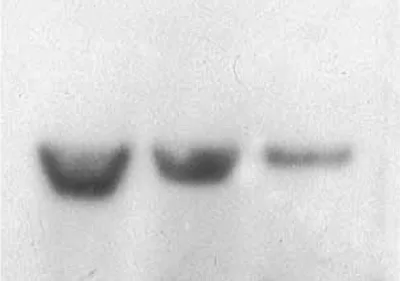
Southern blot of the E. coli phosphoenolpyruvate carboxylase gene. Various dilutions of a 1.3 kb PCR product of the E. coli ppc gene was labeled with PHOTOPROBE® (LA) Biotin and hybridized to immobilized Tsp509 I-digested E. coli genomic DNA. Probe was detected with Alkaline Phophatase Streptavidin followed by DuoLuX™ Substrate visualized by chemiluminescence.
References:
1. Garcia-Gonzalez, D. et al. Cognition based bTBI mechanistic criteria; a tool for preventive and therapeutic innovations. Scientific Reports. 2018 (https://www.nature.com/articles/s41598-018-28271-7)
Applicable patents and legal notices are available at legal notices.
Stay in the Loop. Join Our Online Community
Together we breakthroughTM

©Vector Laboratories, Inc. 2024 All Rights Reserved.